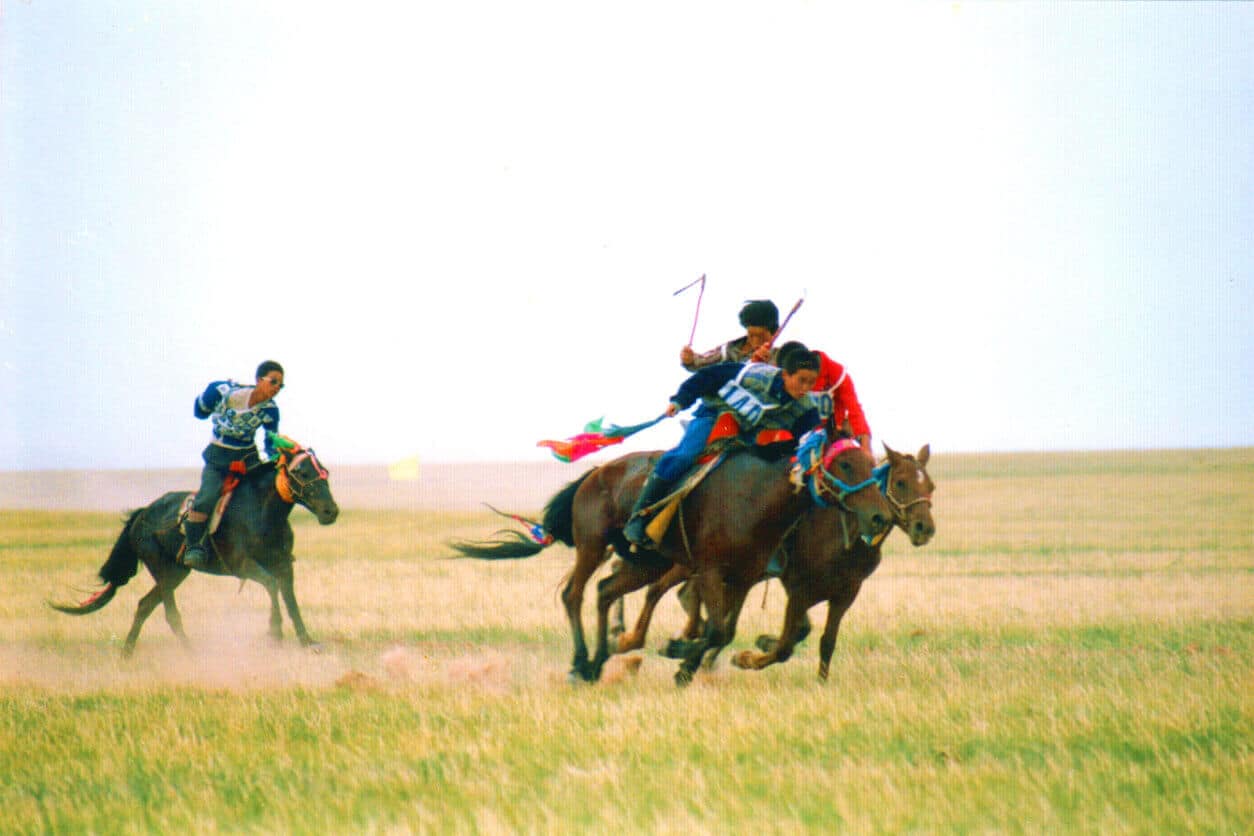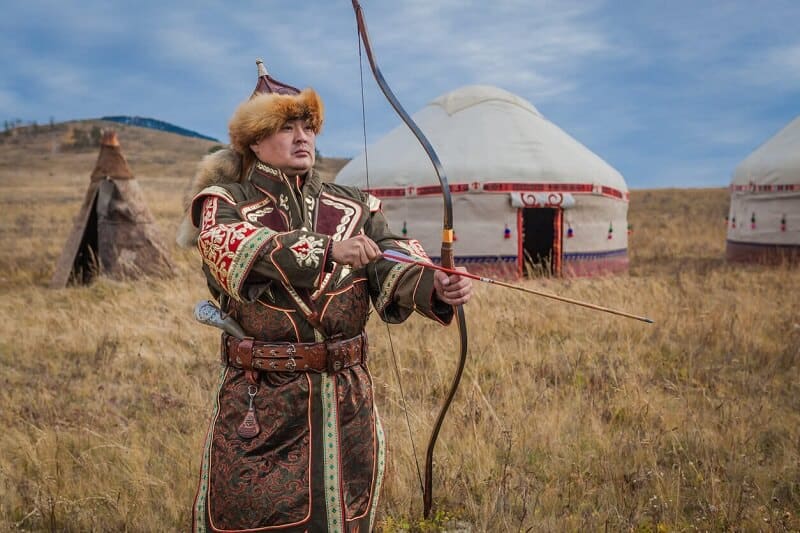Mongolian wrestling, known as “Bökh,” is a traditional sport that is an integral part of the Mongolian cultural heritage and one of the “Three Manly Skills” of Mongolia, alongside horse racing and archery. It is notably featured during the Naadam Festival, held annually in July to celebrate the nation’s independence and honor the nomadic people’s traditional lifestyles.

Mongolian wrestling Rules
Mongolian wrestling matches do not have weight classes, making the competition open and based purely on skill and strength.
The objective is straightforward: wrestlers must get their opponent to touch the ground with any part of the body other than the feet. There are no time limits, and a match continues until one wrestler is defeated.
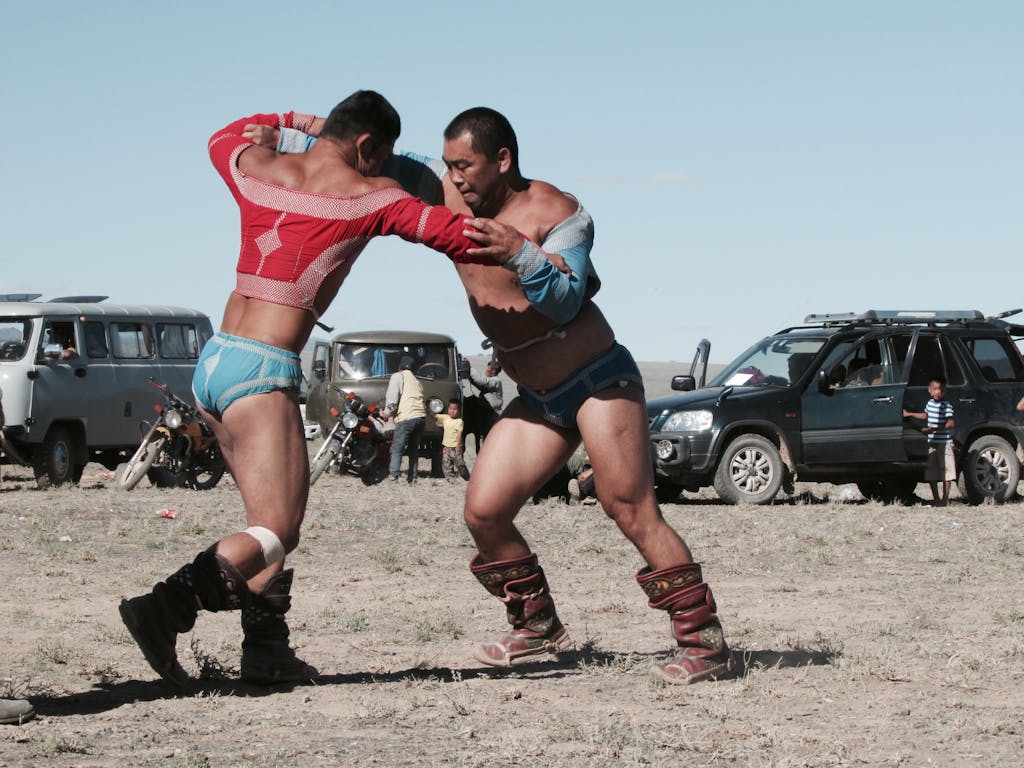
Mongolian wrestling outfit
Wrestlers wear specific traditional attire that includes a “zodog” (a tight, sleeveless jacket), “shuudag” (shorts), and sometimes a “gutal” (Mongolian boots), which are all designed to withstand the rigors of the sport. The attire plays a strategic role, as wrestlers can grab the sleeves and shoulders of the zodog to gain leverage and control over their opponents.
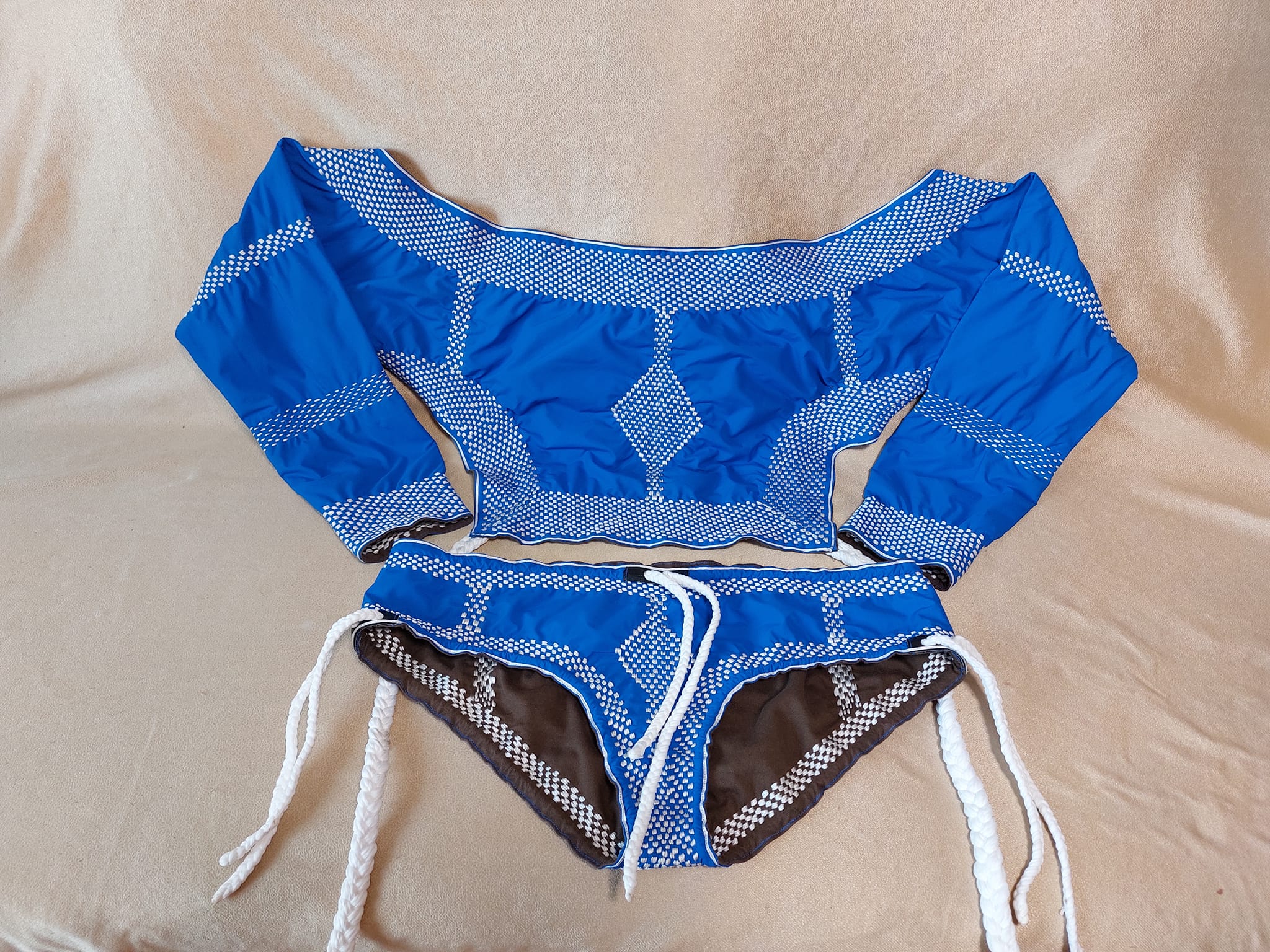
Cultural Significance:
The sport not only displays physical prowess but also respects and ceremonies that reflect Mongolian nomadic traditions.
Before and after each match, wrestlers perform the “Eagle Dance” (Devekh), symbolizing strength and agility, mimicking an eagle’s movements. This dance also shows respect to the judges and the audience.
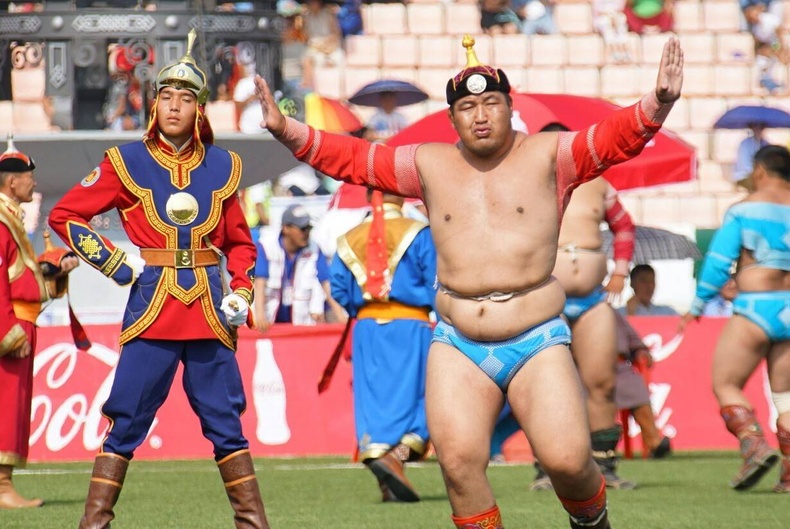
The sport is deeply woven into the social fabric of Mongolia, with wrestlers often revered as heroes and role models, and successful wrestlers can achieve significant social status. Bökh is more than just a sport; it’s a living exhibition of Mongolian culture, heritage, and the spirit of its people.
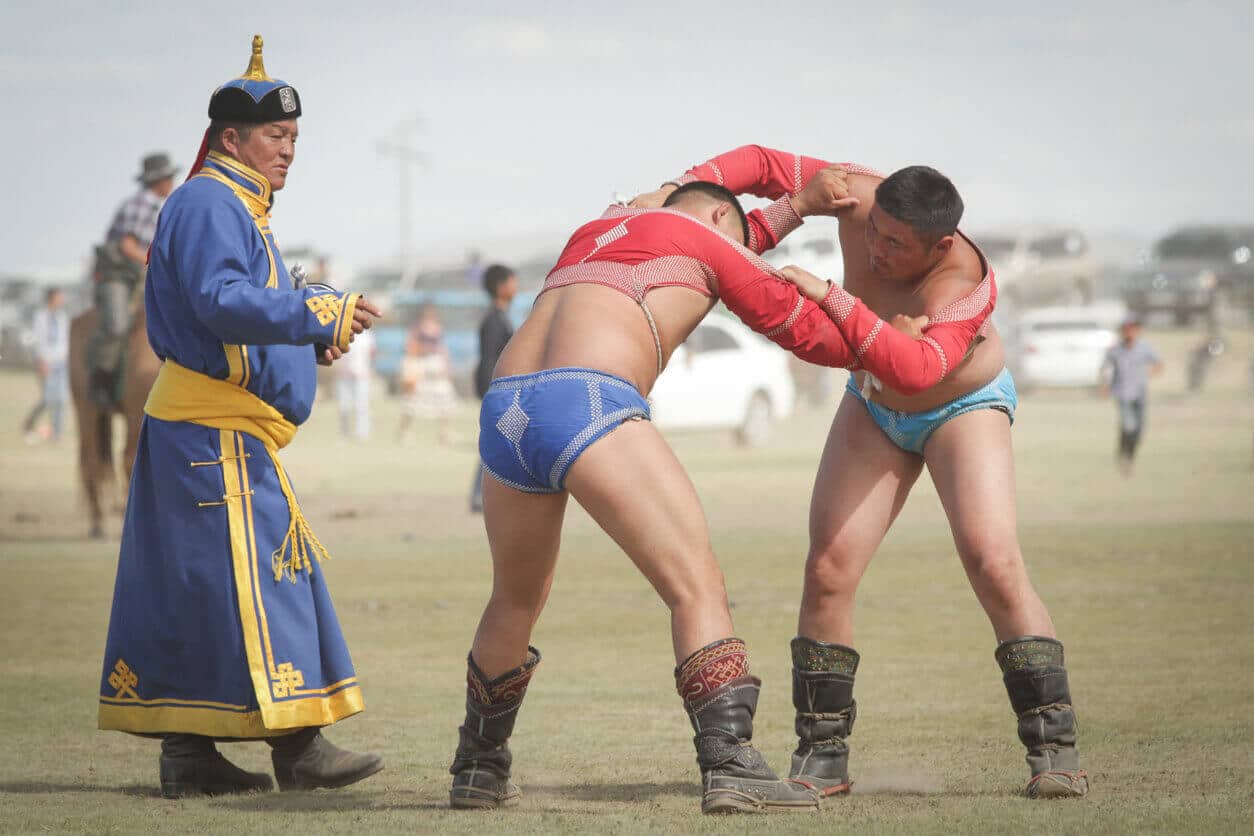
So here are some interesting facts about Mongolian Wrestling
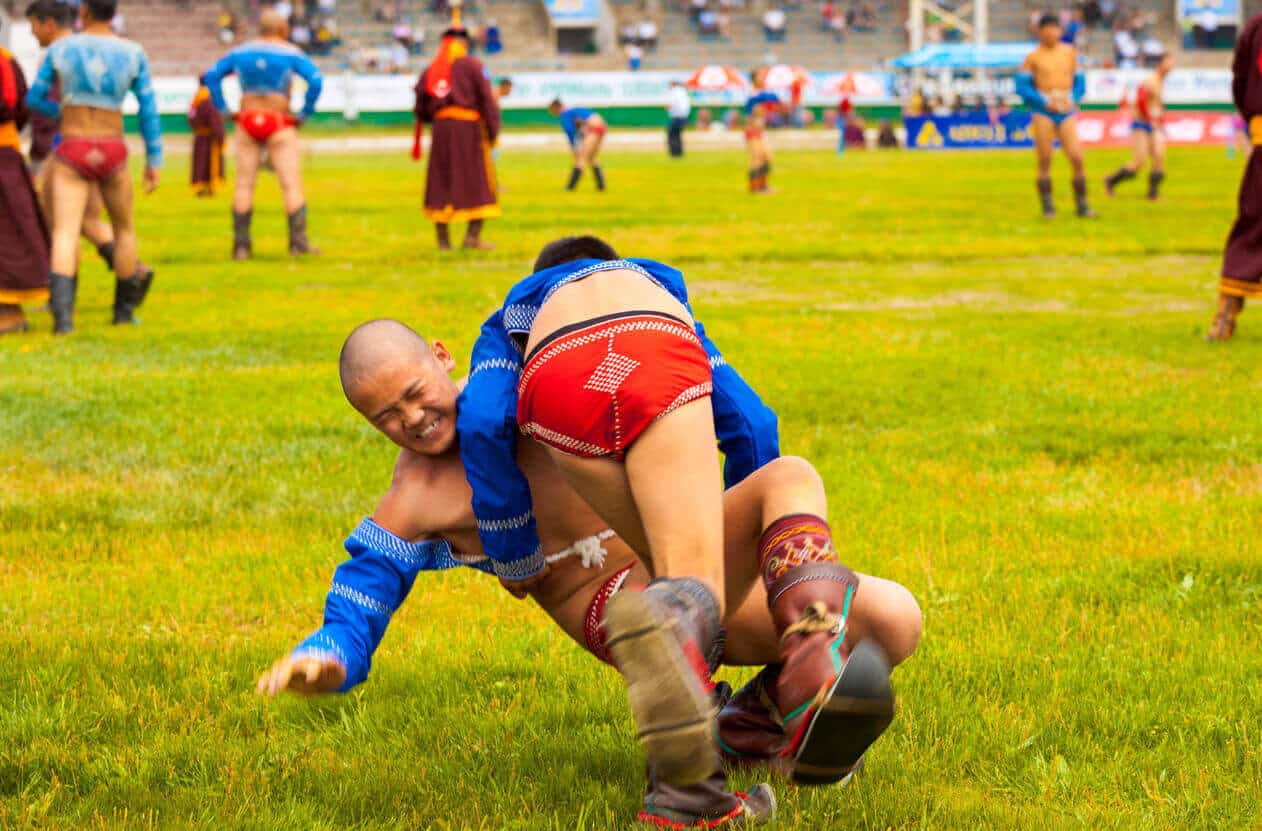
Fact#1 Mongolian wrestling rules
- In Mongolian wrestling, if any part of the opponent’s body other than his or her soles of the feet and palms of the hands comes into touch with the floor, that person wins. Mongolian wrestlers use mekhs, various techniques that capitalize on an opponent’s strengths and weaknesses.
- A combination of throws, trips and lifts are used to bring the other wrestler down. It is a game of strategy, weight and strength. Experienced Mongolian viewers know how a certain technique works and immediately yell with excitement if such an ‘air technique’ becomes successful.
- There are no time limits for each round of wrestling, and wrestlers must wrestle once per round. The winners then advance to the next round while the losing wrestler respectfully passes under the arm of the winner as a sign of respect (tahima uguh).
- The wrestling match starts with the wrestlers slapping their thighs three times to symbolize strength. They then continue from a standing position, and they can touch any part of their opponent’s body. However, they must be respectful of each other’s heads.
- The Mongolian wrestler’s Zasuul is the on-field mentor and coach of the wrestler. In lower rounds, when there are a lot of wrestlers, most competitors do not have their own zasuuls. Wrestlers who make it to the later rounds acquire personal zasuuls. The role of a Zasuuls is to hold his wrestler’s hat while he competes and offer encouragement and inspiration on the field.
- Wrestlers have little or no limit of space. In the open field they are free to move over a wide area and they have little time constraint.
Fact# 2 Mongolian wrestling rankings
There is no categorization according to weight and the basic rule of wrestling is the number of wrestlers must be equal. Usually, 512 wrestlers compete in 9 elimination rounds for two days. Occasionally there are 1,024 wrestlers competing for 10 elimination rounds during special anniversary years.
The losers are eliminated after each round, and the winners advance to compete against other players. This process continues until there is only one player remaining, who is declared the winner. The number of rounds may vary depending on whether it is a rural Naadam.
The title a wrestler receives varies based on the type of Naadam festival (State, provincial, or town), what round they win in, and their previous titles. The competition becomes more interesting round by round.
The wrestlers’ titles are named for birds of prey and strong animals, including the titles of Falcon, Elephant, Hawk, Garuda, Lion, and Champion. In ascending order, the ranks are:
- Falcon (Nachin, 5th round)
- Hawk (Hartsaga, 6th round)
- Elephant (Zaan, 7th round)
- Garuda (8th round)
- Lion (Arslan, 9th round)
- Titan (Avarga, the winner from amongst the Lion rank).
The ranks given are names of powerful winged creatures or animals considered to be the strongest on earth. With each victory at the national Naadam festival, an epithet is added to the title of Avarga – such as “Invincible Titan” or “Invincible Titan to be remembered by all.”
Fact# 3 History of Mongolia Wrestling
The most popular of all Mongol sports is Mongolian wrestling, which has been practiced in Mongolia for hundreds of years. According to some historians, wrestling in the style of the Mongols first appeared over seven thousand years ago.
Neolithic cave paintings in Mongolia’s Bayankhongor Province dating from 7000 BC show two naked men grappling while surrounded by a crowd. The art of Bökh appears on bronze plates discovered in the ruins of the Xiongnu empire (206 BC–220 AD).
Wrestling has roots in military training, as a way to build strength, stamina and combat skills. Genghis Khan used it to keep his troops in shape, and sometimes as a tool for political elimination – there are also records of Kahn using wrestling matches as a way to kill political rivals.
The Manchu dynasty (1646-1911) sponsored frequent freestyle wrestling matches, notably between Manchu and Mongol athletes. In traditional Mongolian culture, Mongols who engage in athletic activities such as wrestling are highly regarded.
Wrestlers are especially valued in traditional Mongolian society because they are seen to reflect ancient notions of aristocracy, strength, and sportsmanship. Mongolian wrestling competitions’ ceremonies have stayed the same for centuries.
Fact#4 Mongolian Wrestling Outfit
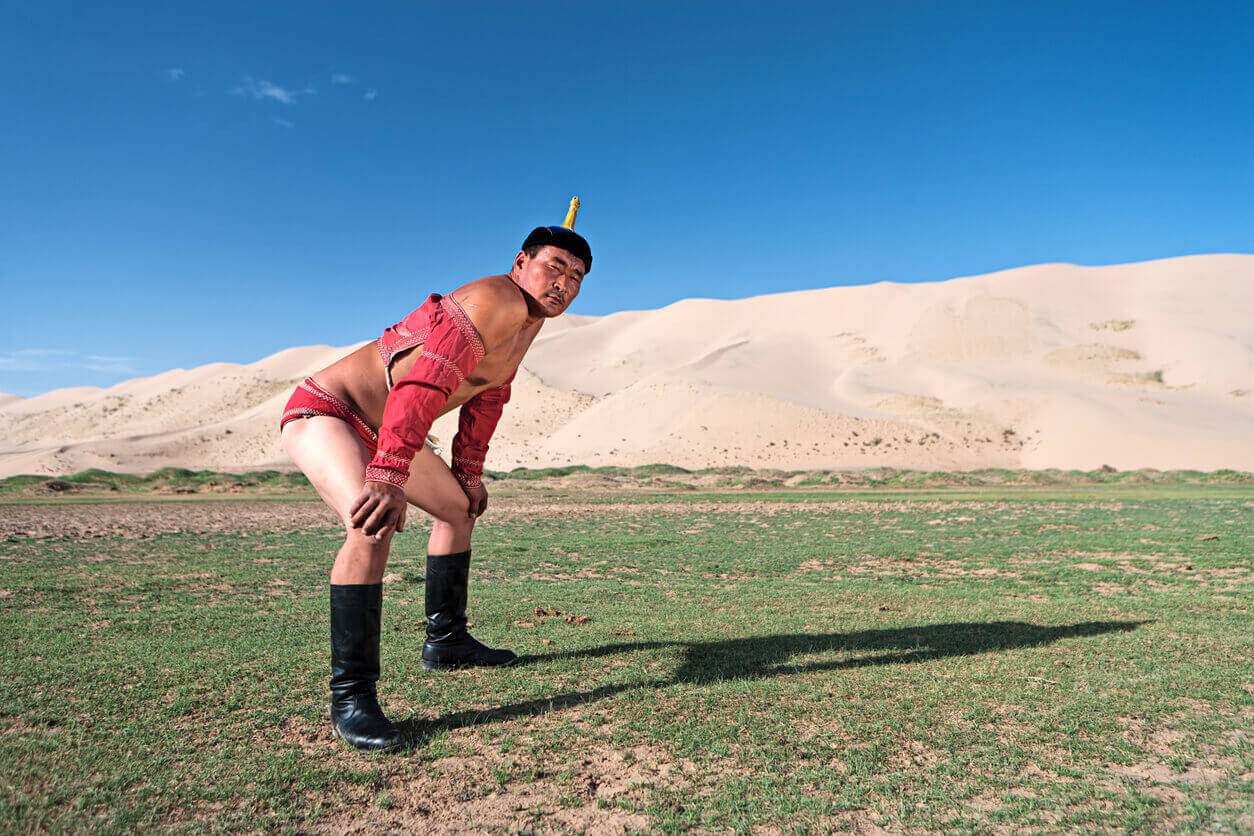
Wrestlers wear special clothes which show the beauty and strength of their bodies. The wrestlers’ costumes consist of:
- traditional boots featuring upturned toes
- a pointed-top traditional hat
- A tight, collarless, heavy-duty short-sleeved jacket of red or blue color. (Called Zodog in Mongolia)
- Small, tight-fitting briefs made of red or blue colored cotton cloth (Called Shuudag in Mongolia)
The Mongolian wrestling outfit is made of fine silk, leathers, felt, and rope. The jackets and trunks are sometimes painted red and light blue to represent the nation’s flag.
The wrestler’s cap has four sides with a variety of animal emblems on them that reflect the wrestler’s rank, as well as crimson ribbons draped down.
The color and number of lines on the hat ribbons indicate the wrestler’s title and ranking.
Fact# 5 Interesting Legends of Mongolian Wrestling
Mongolian wrestling has many interesting legends associated with it. One legend says that when the world was young, the gods created humans and animals. To keep humans and animals from fighting, the gods held a great wrestling match.
The winner of this match would become the ruler of all and would have the power to create whatever they wanted. The match was held between a human and an animal, with each side having their own champion. The human champion was a great wrestler named Mongol Zooti. The animal champion was a huge bull.
The match went on for days, with neither side able to gain an advantage. Finally, the bull became so tired that Mongol Zooti was able to throw him. From that day on, humans have ruled the world, and animals have been subservient to humans.
One tale claims that Mongolian wrestlers originally wore more clothing to cover their bodies. But a woman dressed as a man ended up winning the competition, and it was later revealed that she was actually female. So now, the traditional wrestling costume is open-chested.
Fact# 6 Interesting etiquettes of Mongolian Wresting
- When a Mongol wrestler’s clothes loosen or tangle during a match, his opponent is supposed to stop attacking and help the former fix them–even if it might mean sacrificing a good chance to win. The wrestler who loses unties his jacket as a sign of respect for his opponent’s strength.
- The red ribbons on the wrestlers’ hats identify them, and some also have yellow lines. The number of yellow lines corresponds to rank—the more lines, the higher the rank. While they’re competing, wrestlers leave their hats with coaches so that spectators can enjoy trying to recognize them. There’s usually more excitement when a high-ranking wrestler wins, but if he falls or is strongly challenged by a lower-ranking or young wrestler, that’s when the real Naadam starts. People get excited and wait for new champions and title winners.
- The “Eagle Dance” is a traditional dance performed by wrestlers before and after their match. The dance is based on the flight of the mythical Garuda bird, which symbolizes power, bravery, grace and invincibility. Different locales have different dancing styles. For example, in Mongolia the wrestler imitates falcons or phoenix taking off. Today, people regard the dance not only for its aesthetic value but also as a way to warm-up and cool-down before and after an intense fight. Good wrestlers take the dance seriously and often become better dancers because of it. This unique dance is an integral part of wrestling tradition that helps define it.
How do Mongolian wrestlers train?
Mongolian wrestlers start their training early in childhood. By the time they’re seven or eight years old, they’ve usually started to learn the basic moves and principles of Mongolian wrestling from their fathers or grandfathers.
If they enjoy what they learn, your children can join wrestling clubs which are located all around Mongolia. With many options for coaches and clubs, it is essential to pick the right one that best fits you.
Although more youth in today’s society are not growing up with traditional herding culture and values, these lessons can still be taught by a good wrestling coach.
It’s unlikely that many children will grow up to become professional wrestlers, but the sport will always remain a fond memory of their childhood.
In addition, it instills a deep appreciation of traditional culture – one which they are likely to pass on to future generations and ensure that Mongolian culture lives on.
Famous Mongolian Wrestlers
Mongolian wrestling has a long and interesting history, full of powerful athletes who have become legends. Many people still find it hard to believe that one man fought a bear and lifted almost a ton – but these stories are still retold like myths among the Mongolian people.
Here, we would like to introduce you to some of these legendary strongmen, whose tricks and feats of strength continue to amaze fans even today.
- Namkhai, who won the Naadam 19 times and seven more times finished second, is considered to be one of the most successful wrestlers. In 1895, he was the first to win a Naadam bout.
- In the modern era, just 20 modern wrestlers have reached Giant status (since 1921). Badmaanyambuugiin Bat-Erdene is regarded to be the most successful wrestler in the current era, with 11 title victories. In 1990, he won both Naadam and the Secret History of the Mongols for Mongolia’s 750th anniversary.

- O. Tulgaa, a well-known Elephant ranked Wrestler of the Uvs province, has many great memories. Moving a stone weighing 156 kg and winning a bet was one of them. Mongolia’s and Russia’s leaders met at the border during the 1985 holiday. A Russian leader, on the other hand, pointed to a huge rock on the mountain that separates their two countries and vowed that they would give 500 rubles to anyone who lifts it and walks 100 times across it. A young man from Tuva picked up this stone but lost it after only ten steps. But Tulgaa Avarga lifted the pole and walked 100 steps. The chief shook his head and gave him the money he promised. Now, the stone with the inscription “The Mighty Elephant of Mongolia Raised the Pillar of Ulzi” is kept in Tuva’s Museum.
- D. Perenleidorj, a native of Arhangai Province, is the person who made the story of wrestlers carrying their mother and family along with them a reality in modern times. In 2006, when he appeared on the “Mongolian Miracle” program, he carried a house with four walls and walked from the Children’s House to the park. It is said that he not only carried a house, but also carried a weight of 50 kg in both hands. D. Perenleidorj rested four times while covering more than one kilometer. Later, when the load was weighed, it was more than 400 kg. That’s all I can say about his mighty strenght
Mongolia Olympics Wrestling
Over the past ten years, Mongolian wrestlers have achieved success in Japanese sumo and Olympics through adapting traditional Mongolian wrestling techniques to their strength training. By utilizing what they already knew, these athletes were able to excel in a different field by simply making some adjustments.
Dolgorsürengiin Dagvadorj, also known as Asashōryū Akinori, became the first Mongolian to reach sumo’s highest rank in January 2003. He is the 68th yokozuna in the history of sportswomanship in Japan. In 2005, he accomplished a year-long goal by winning all six official sumo tournaments (honbasho) within a single calendar year.
Naidangiin Tüvshinbayar won Mongolia’s first gold medal in Judo Men’s half heavyweight division during the 2008 Beijing Olympics.
Frequently asked questions
Why is wrestling so popular in Mongolia?
Mongolian wrestling has a long history, and it is deeply ingrained in the culture. For Mongolians, wrestling is more than just a sport – it is a way of life. Wrestling is seen as a test of strength, courage and skill, and it is an excellent way for young men to prove their manhood.
What is Mongolian wrestling called?
Mongolian wrestling is called Bökh, which means “firmness or wrestler.” It is a form of folk wrestling that is similar to sumo wrestling, and it is the national sport of Mongolia.
Hello. My name is Anujin. I was born and raised in Ulaanbaatar, the capital city of Mongolia. I am senior writer at CorrectMongolia, where I share the culture , tradition of my country.
Do you have any questions or comments about this post? Let us know in the comments below!
Related Content:
Mongolian Horse Race: World’s Toughest Horse Race
Mongolian Archery: 4 interesting things about them
Naadam Festival 3 Unique Events You Won’t Want to Miss
Share to Public

